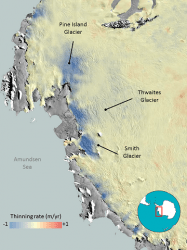The West Antarctic Ice Sheet is losing the equivalent of a Lake Tahoe in ice every single year, according to new measurements from the European Space Agency CryoSat satellite — quite a bit more than what was measured earlier. That’s 36 cubic miles or 150 cubic kilometers every single year.
The measured loss also affects sea levels around the world. Between 2005 and 2010, polar scientists previously calculated, oceans rose about 0.0110 inches (0.28 mm) a year due to West Antarctic melting. The new results suggest that the melting is about 15% higher. That would put the new sea-rise rate at 0.0115 inches (0.32 mm) a year.
“We find that ice thinning continues to be most pronounced along fast-flowing ice streams of this sector and their tributaries, with thinning rates of between 4–8 m [13 to 26 feet] per year near to the grounding lines – where the ice streams lift up off the land and begin to float out over the ocean – of the Pine Island, Thwaites and Smith Glaciers,” stated Malcolm McMillan, a research fellow at the United Kingdom’s University of Leeds.

What scientists don’t know is whether the ice is thinning faster due to melting glaciers or if CryoSat — the European Space Agency satellite that made these measurements by radar following its launch in 2010 — is simply mapping the same rate of loss but in higher resolution as what was seen before.
“Thanks to its novel instrument design and to its near-polar orbit, CryoSat allows us to survey coastal and high-latitude regions of Antarctica that were beyond the capability of previous altimeter missions, and it seems that these regions are crucial for determining the overall imbalance,” stated Andrew Shepherd, a University of Leeds researcher who led the study.
The research was presented at the American Geophysical Union’s fall meeting this week.
Source: European Space Agency


The current overall sea rise rate from all causes, as noted in Wikipedia, is 3mm/year. This rate is widely expected to accelerate as time passes and the heat imbalance behind AGW gets worse.
However, the Antarctica ice sheet is larger than any other time in recorded history. Stick that in yer AGW pipe and smoke it.